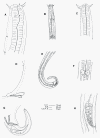|
.
Tripylina montecilloensis (female).
A,C: Anterior end. B: Pharynx. D: Preanal papillae. E: Posterior end. F:
Pharyngeo-intestinal junction. G: Tail. H: Vulva region.
from Cid del Prado et al., 2012
|
Female:
Body C-shaped upon fixation.
Cuticle 1.0-3.0 μm thick, with fine transverse
striation visible under SEM; body pores absent but somatic setae, each
surrounded by a cuticular ring at the base, sparsely distributed along the
body.
Lip region asymmetric, conoid, continuous with body
contour, 14-23 μm wide at the base of the outer labial setae.
Oral aperture surrounded by three lips; two
conical inner labial papillae at the base of each lip; outer labial setae
10-15 μm long; cephalic setae conical, 5-10 μm long, 1.5 μm behind the outer
labial setae.
Amphid apertures small, oval, at level of the
dorsal tooth, 15-26 μm of from the anterior end.
Two ventromedian cervical setae, 22 μm apart, at
60-100 μm behind the lip region.
Dorsal wall of stoma not thickened; dorsal tooth
small, located at 14-20 μm from the anterior end and 3-6 μm behind the
subventral teeth.
Cardia relatively small, 10-16 μm long and 10-29 μm
wide, with two pericardiac cells.
Distance from pharynx base to vulva 349-556 μm and
to anus 514-1034 μm.
Nerve ring at 60-96 μm from the anterior end.
Excretory pore indiscernible.
Genital system monodelphic-prodelphic, 75-174 μm
long: ovary reflexed, vagina lacking sclerotized pieces, and vulval lips not
protruding.
Tail curved ventrad, ending in a small spinneret;
latero-dorsal
setae lacking.
Male:
Unknown.
|